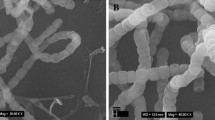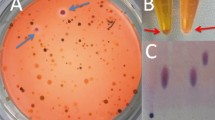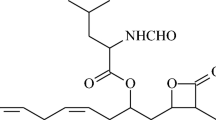Abstract
(R)-3-Hydroxycarboxylic acids, chiral enantiomers of bacterial polyhydroxyalkanoates (PHA), may be valuable synthons for the production of numerous industrial materials such as β-lactams, fungicides, flavors, pheromones and vitamins. In this study, (R)-3-hydroxycarboxylic acid [(R)-3HAs)] synthons were produced by Streptomyces sp. JM3 (JN166713) under batch fermentation. Initial confirmation of PHA production was achieved by matrix assisted laser desorption ionization-time of flight mass spectroscopy and gas chromatography/mass spectroscopy (GC/MS). Subsequently, (R)-3HAs were produced by in vivo depolymerization and the monomers were separated using acid precipitation and anion exchange chromatography. The (R)-3HAs were identified by GC/MS as 3-trimethylsiloxy esters of decanoic, octanoic and butanoic acids. This was further supported by 13C nuclear magnetic resonance spectrometry. The (R)-3HAs exhibited antimicrobial activity against Escherichia coli O157:H7, Listeria monocytogenes (ATCC 7644) and Salmonella typhimurium (ATCC 14028) with minimum inhibitory concentration ranging from 12.5 to 25 mg ml−1. However, the minimum bactericidal concentration data suggest that the (R)-3HAs may be bactericidal for E. coli O157:H7 and bacteriostatic for S. typhimurium and L. monocytogenes. Furthermore, the major purified synthon was shown to minimize the invasion of fibroblasts by S. typhimurium (ATCC 14028) [p < 0.05], using the MTT assay [(3-(4,5-dimethylthiazol-2-yl)-2,5-diphenyltetrazolium bromide)].







Similar content being viewed by others
References
Allen AD, Anderson WA, Ayorinde FO, Eribo BE (2010) Biosynthesis and characterization of copolymer poly(3HB-co-3HV) from saponified Jatropha curcas oil by Pseudomonas oleovorans. J Ind Microbiol Biotechnol 37:849–856
Allen AD, Anderson WA, Ayorinde FO, Eribo BE (2011) Isolation and characterization of an Extracellular Thermoalkanophilic P(3HB-co-3HV) Depolymerase from Streptomyces sp. IN1. Int Biodeter Biodegr 65:777–785
Andersson DI (2003) Persistence of antibiotic resistant bacteria. Curr Opin Microbiol 6:452–456
Atkins GJ, Haynes DR, Geary SM, Loric M, Crotti TN, Findlay DM (2000) Coordinated cytokine expression by stromal and hematopoietic cells during human osteoclast formation. Bone 26:653–661
Ayorinde FO, Saeed KA, Price E, Morrow A, Collins WE, Pollack SK, McInnis F, Eribo BE (1998) Production of poly-(β-hydroxybutyrate) from saponified Vernonia galamensis oil by Alcaligenes eutrophus. J Ind Microbiol Biotechnol 21:46–50
Bai XC, Lu D, Liu AL, Zhang ZM (2005) Reactive oxygen species stimulates receptor activator of NF-Κb ligand expression in osteoblast. J Biol Chem 280:17497–17506
Berchmans JH, Hirata S (2008) Biodiesel production from crude Jatropha curcas L. seed oil with a high content of free fatty acids. Biores Technol 99:1716–1721
Bergsson G, Steingrimsson O, Thormar H (2002) Bactericidal effects of fatty acids and monoglycerides on Helicobacter pylori. Int J Antimicrob Agents 42:258–262
Chitemerere TA, Mukanganyama S (2011) In vitro antibacterial activity of selected medicinal plant from Zimbabwe. Afr J Plant Sci Biotechnol 5:1–7
de Roo G, Kellerhals M, Ren Q, Witholt B, Kessler B (2002) Production of chiral R-3-hydroxyalkanoic acids and R-3-hydroxyalkanoic acid methyl esters via hydrolytic degradation of polyhydroxyalkanoates synthesized by pseudomonads. Biotechnol Bioeng 77:717–722
Defroidt T, Boon N, Sorgeloos P, Verstraete W, Boddier P (2009) Short chain fatty acids and poly-β-hydroxyalkanoates (new) biocontrol agents for a sustainable animal production. Biotechnol Adv 27:680–685
Deurenberg RH, Vink C, Kalenic S, Friedrich AW, Bruggeman CA, Stobberingh EE (2007) The molecular evolution of methicillin-resistant Staphylococcus aureus. Clin Microbiol Infect 13:222–235
Gottlib D, Shirling EB (1967) Cooperative description of type cultures of Streptomyces. Int J Syst Bacteriol 17:315–322
Gubitz GM, Mittelbach M, Trabi M (1999) Exploitation of the tropical oil seed plant Jatropha curcas L. Biores Technol 67:7382
Haas W, Mittelbach M (2000) Detoxification experiments with the seed oil from Jatropha curcas L. Ind Crops Prod 12:111–118
Haywood GW, Anderson AJ, Chu L, Dawes EA (1988) Characterization of two 3-ketothiolase possessing differing substrate specificities in the polyhydroxyalkanoates synthesizing organism Alcaligenes eutrophus. FEMS Microbiol Lett 52:91
He X, Ahn J (2011) Survival and virulence properties of multiple antibiotic-resistant Salmonella typhimurium under simulated gastrointestinal conditions. Int J Food Sci Tech 46:2164–2172
Kannan LV, Rehacek Z (1970) Formation of poly-β-hydroxybutyrate by Actinomycetes. Indian J Biochem Biophys 7:126–129
Kashiwaya Y, Takeshima T, Mori N, Nakashima K, Clarke K, Veech RL (2000) D-β-hydroxybutyrate protects neurons in models of Alzheimer’s and Parkinson’s disease. Proc Natl Acad Sci 97:5440–5444
Levy SB (2002) Factors impacting on the problem of antibiotic resistance. J Antimicrob Chemother 49:25–30
Li R, Zhang H, Qi Q (2007) The production of polyhydroxyalkanoates in recombinant Escherichia coli. Biores Technol 98:2313–2320
Manna A, Banarjee R, Paul AK (1999) Accumulation of poly(3-hydroxybutyric acid) by some soil Streptomyces. Curr Microbiol 39:153–158
Martinson E, Samuelson O (1970) Automatic chromatography of hydroxy acids on anion-exchange resins. Chromatographia 3:405–410
Nath A, Bhat S, Devle J, Desai A (2005) Enhanced production of 3-hydroxybutyric acid (3-HB) by in vivo depolymerization of polyhydroxybutyric acid in 3-HB dehydrogenase mutants of Methylobacterium spp. ZP24. Ann Microbiol 55:107–111
Raj SM, Rathnasingh C, Jo JE, Park S (2008) Production of 3-hydroxypropionic acid from glycerol by novel recombinant Escherichia coli BL21 strain. Process Biochem 43:1440–1446
Rathore V, Madras G (2007) Synthesis of biodiesel from edible and non-edible oils in supercritical alcohols and enzymatic synthesis in supercritical carbon dioxide. Fuel 86:2650–2659
Ren Q, Grubelnik A, Hoerler M, Ruth K, Hartman R, Felber H, Zinn M (2005) Bacterial poly(hydroxyalkanoates) as a source of chiral hydroxyalkanoic acids. Biomacromolecules 6:2290–2298
Ren Q, Katinka R, Thöny-Meyer L, Zinn M (2010) Enatiomerically pure hydroxycarboxylic acids: current approaches and future perspectives. Appl Microbiol Biotechnol 87:41–52
Ricke SC (2003) Perspectives on the use of organic acids and short chain fatty acids as antimicrobials. Poult Sci 82:632–639
Ruth K, Grubelnik A, Hartmann R, Egil T, Zinn M, Ren Q (2007) Efficient production of (R)-3-hydroxycarboxylic acids by biotechnological conversion of polyhydroxyalkanoates and their purification. Biomacromolecules 8:279–286
Sandoval A, Arias-Barrau E, Bermejo F, Canedo L, Naharro G, Olivera E, Luengo J (2005) Production of 3-hydroxy-n-phenylalkanoic acids by genetically engineered strains of Pseudomonas putida. Appl Microbiol Biotechnol 67:97–105
Sarker SD, Nahar L, Kumarasamy Y (2007) Microtitre plate-based antibacterial assay incorporating resazurin as an indicator of cell growth, and its application in the in vitro antibacterial screening of phytochemicals. Methods 42:321–324
Shirling EB, Gottlieb D (1966) Methods for characterization of Streptomyces species. Int J Sys Bacteriol 16:313–340
Sudesh K, Abe H, Doi Y (2000) Synthesis, structure and properties of polyhydroxyalkanoates: biological polyesters. Prog Polym Sci 25:1503–1555
Sun Z, Ramsay J, Guay M, Ramsay B (2009) Enhanced yield of medium-chain-length polyhydroxyalkanoates from nonanoic acid by co-feeding glucose in carbon-limited, fed-batch culture. J Biotechnol 143:262–267
Van Immerseel F, De Buck J, Pasmans F, Velge P, Bottrew E, Fievez V et al (2003) Invasion of Salmonella enteritidis in avian intestinal epithelial cells in vitro is influenced by short-chain fatty acids. Int J Food Microbiol 85:237–248
Verma S, Bhatia Y, Valappil SP, Roy I (2002) A possible role of poly-3-hydroxybutyric acid in antibiotic production in Streptomyces. Arch Microbiol 179:66–69
Yu J, Stahl H (2008) Microbial utilization and biopolyester synthesis of bagasse hydrolysates. Bioresour Technol 99:8042–8048
Zhang X, Aubin JE, Kim TH, Payne U, Chiu B, Inman R (2004) Synovial fibroblasts infected with Salmonella enterica Serovar Typhimurium mediate osteoclast differentiation and activation. Infect Immun 72:7183–7189
Zhao Y, Zou B, Shi ZY, Wu Q, Chen GQ (2007) The effects of 3-hydroxybutyrate on the in vitro differentiation of murine osteoblast MCM-E1 and in vivo bone formation in ovariectomized rats. Biomaterials 28:3063–3073
Acknowledgments
We would like to express our sincere gratitude to Dr. Oumar Diall from the University of Mali for the gift of the Jatropha curcas oil. Some aspects of this work were supported through the Howard Hughes Core Laboratory at Howard University.
Author information
Authors and Affiliations
Corresponding author
Rights and permissions
About this article
Cite this article
Allen, A.D., Daley, P., Ayorinde, F.O. et al. Characterization of medium chain length (R)-3-hydroxycarboxylic acids produced by Streptomyces sp. JM3 and the evaluation of their antimicrobial properties. World J Microbiol Biotechnol 28, 2791–2800 (2012). https://doi.org/10.1007/s11274-012-1089-z
Received:
Accepted:
Published:
Issue Date:
DOI: https://doi.org/10.1007/s11274-012-1089-z




